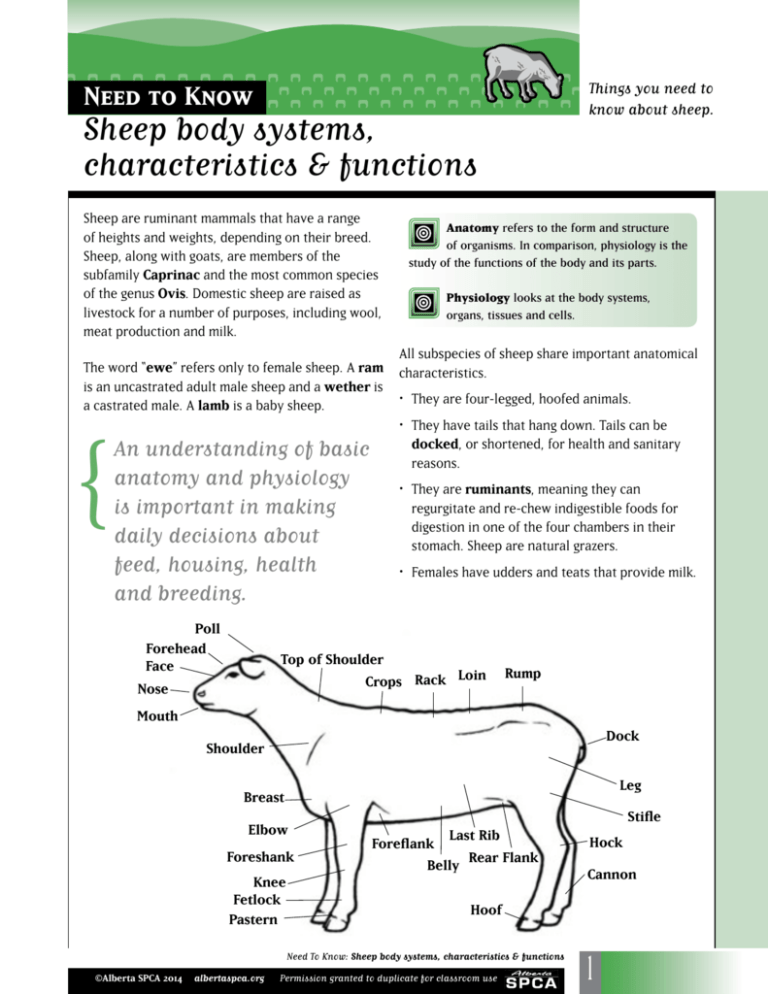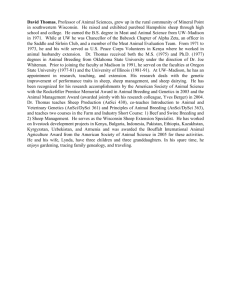Sheep body systems, characteristics & functions
advertisement

Things you need to
know about sheep.
Need to Know
Sheep body systems,
characteristics & functions
Sheep are ruminant mammals that have a range
of heights and weights, depending on their breed.
Sheep, along with goats, are members of the
subfamily Caprinac and the most common species
of the genus Ovis. Domestic sheep are raised as
livestock for a number of purposes, including wool,
meat production and milk.
Anatomy refers to the form and structure of organisms. In comparison, physiology is the
study of the functions of the body and its parts.
Physiology looks at the body systems,
organs, tissues and cells.
All subspecies of sheep share important anatomical
The word “ewe” refers only to female sheep. A ram characteristics.
is an uncastrated adult male sheep and a wether is
• They are four-legged, hoofed animals.
a castrated male. A lamb is a baby sheep.
• They have tails that hang down. Tails can be or shortened, for health and sanitary An understanding of basic docked,
reasons.
{
anatomy and physiology
is important in making
daily decisions about
feed, housing, health
and breeding.
Poll
Forehead
Face
Nose
• They are ruminants, meaning they can regurgitate and re-chew indigestible foods for digestion in one of the four chambers in their stomach. Sheep are natural grazers.
• Females have udders and teats that provide milk.
Top of Shoulder
Crops Rack Loin
Rump
Mouth
Dock
Shoulder
Leg
Breast
Elbow
Foreshank
Knee
Fetlock
Pastern Coffin
Stifle
Last Rib
Foreflank
Belly Rear Flank
Hock
Cannon
Hoof
Need To Know: Sheep body systems, characteristics & functions
©Alberta SPCA 2014 albertaspca.org Permission granted to duplicate for classroom use
1
KNOW WHY THE SKELETAL SYSTEM IS IMPORTANT
The sheep skeletal system supports the animal’s
body and weight and is the frame upon which the
The skeletal system is one of the systems that make muscles and internal organs are connected. The
up any animal body. It is the framework on which
skeleton is made up of the vertebral column, ribs
the body is built and supports the weight of all the and skull, limbs and joints.
other systems. The skeletal system includes bones,
muscles, the joints that connect bones, ligaments
The vertebral column is made up of both fixed and
which allow movement in the joints and cartilage.
movable bones. The ribs are long curved bones
Therefore, the skeletal system is also fundamental that form the ribcage, which protects essential
to the movement of the body.
organs. The skull includes all the bones of the
{
An understanding of
the basics of the
skeletal system ensures
that owners and handlers
provide sheep with
appropriate nutrition,
exercise and living
conditions for optimum
skeletal health.
2
head, including the lower jawbone, which forms a
movable joint with other parts of the skull.
Limbs include the forelegs as well as hindlegs.
Forelegs include the shoulder and foreshank
and the lower part of the limb includes the knee,
fetlock and pastern. Hindlegs consist of the pelvis,
thigh and a lower limb made up of the hock joint
and cannon.
Structural soundness refers to the skeletal system and how well its bones support the
animal’s body. Structural soundness affects an
animal’s well-being, movement and reproductive
efficiency.
Need To Know: Sheep body systems, characteristics & functions
©Alberta SPCA 2014 albertaspca.org Permission granted to duplicate for classroom use
KNOW HOW THE DIGESTIVE SYSTEM WORKS
Sheep are ruminant animals. Non-ruminants,
including people, pigs and dogs, digest
carbohydrates, protein and fat by enzymatic
action. Ruminants, including cattle, sheep and
deer, use bacteria in the forestomachs to digest
fibre by fermentation and use enzymatic digestion
in the small intestines. The digestion of this
fibre produces carbon dioxide and methane gas.
Ruminants also digest carbohydrates, protein and
fat this way.
Food is broken down in Esophagus is a simple,
the mouth by chewing; muscular tube between
saliva is added as a
the mouth and stomach.
lubricant.
In the stomach,
including the ruminant
forestomachs,
enzymatic digestion of
proteins is initiated and
foodstuffs are reduced
to liquid form.
The pancreas provides
a mixture of digestive
enzymes to the small
intestine, critical
for digestion of fats,
carbohydrates and
protein.
The large intestine
differs greatly among
species in extent
and importance – in
all animals, water is
absorbed, bacterial
fermentation takes
place and feces are
formed.
The reticulum lies
against the diaphragm
and is joined to the
rumen by a fold of
tissue.
The small intestine is
where the final stages
of chemical enzymatic
digestion occur and
where almost all
nutrients are absorbed.
The rumen is
the largest of the
forestomachs.
The reticulum is
connected to the
spherical omasum by a
short tunnel.
The liver is the centre
of metabolic activity in
the body. Its major role
in the digestive process
is to provide bile salts
to the small intestine,
critical for digestion
and absorption of fats.
Reticulum
Rumen
Omasum
Abomasum
The abomasum is
the ruminant's true or
glandular stomach, and
is very similar to the
mono-gastric stomach
of animals such as the
dog or cat.
Adapted with permission from Sheep and Goat Management in Alberta: Nutrition. http://ablamb.ca/documents/management-modules/
sgma/sgma_nutrition_module.pdf
Need To Know: Sheep body systems, characteristics & functions
©Alberta SPCA 2014 albertaspca.org Permission granted to duplicate for classroom use
3
KNOW WHY THE RESPIRATORY SYSTEM IS
IMPORTANT
The respiratory system is the means by which
animals obtain and use oxygen and eliminate
carbon dioxide.
The respiratory system consists of the lungs and
pleura, nostrils, naval cavities, pharynx, larynx,
trachea and bronchi. The cards that follow provide
a description of the major body parts and function
in the respiratory system.
Nostrils are external
openings to air
passages.
Nostrils provide
external openings for
nasal cavities.
The pharynx is a
passageway for air and
food.
The larynx is the
opening from the
pharynx and is the
organ of sound
production in mammals.
The trachea provides
the air passageway
between the larynx and
bronchi. It is a semiflexible tube.
Bronchi are major
air passages that
are important for
conducting air into the
lungs.
The lungs are main
structures of the
respiratory system.
They are located in
the thorax. When the
thorax expands, the
lungs expand.
The pleura are
membranes that
surround both lungs.
KNOW HOW THE MUSCLE SYSTEM WORKS
A sheep’s head has muscles around the ears to
permit movement so sound can be picked up.
Sheep also have strong jaw muscles so they can
tear and grind tough forage and grasses. Smaller
muscles around the lip area allow them to graze
smaller grains and seeds. Their neck muscles allow
them to hold their heads for balance while moving.
The muscles in the shoulders and torso provide
support and protection for the spine and ribs. The
petoralis muscles form the chest section of the
sheep. The obliques and latissimus muscles are
along the rear and bottom of the torso and protect
and stabilize the abdominal organs.
4
The muscles of the forelimbs and hindlimbs permit
flexibility and allow movement. The hindleg
muscles tend to be the largest and strongest of a
sheep. Deltoids, biceps and triceps are heavier in
meat sheep breeds than in those used for wool
production.
{
Sheep muscles are suited
to activities common to
most small ruminants,
including grazing and
walking or running to
escape predators. Sheep
also have small cutaneous
muscles below the skin
that twitch or shake to
dislodge insect pests.
Need To Know: Sheep body systems, characteristics & functions
©Alberta SPCA 2014 albertaspca.org Permission granted to duplicate for classroom use
KNOW ABOUT THE BASIC BODY PARTS IN THE
REPRODUCTIVE SYSTEM
Males and females play different reproductive
roles, and in most animal species, the role of
females is not completed until a viable offspring
is produced. Even after birth, females play a
significant role in the provision of post-natal
care and, in mammals, must lactate to provide
nourishment for their young.
Uterus
Cervix
{
Vagina
Understanding basic
anatomy and reproductive
physiology of sheep is
important for reproductive
decisions and management.
Vulva
Ovary
Bladder
Uterine
horns
Oviduct
Female Reproductive Organs
The ovaries contain the ova,
or eggs, and secrete female
reproductive hormones,
progesterone and estrogens.
The oviduct, also called fallopian
tubes, transport sperm and ova,
or egg, to the site of fertilization,
which occurs in the upper onethird of the fallopian tube. The
fertilized ovum is then transported
to the uterus.
The uterus consists of two
separate uterine horns. In
animals with multiple births,
each horn can contain one
or more fetuses. The uterus
provides a proper environment
for embryo development,
supports development of the
fetus by supplying nutrients,
removing waste, and protecting
the fetus. It also transports the
fetus out of the maternal body
during birth.
The cervix is the gateway
to the uterus and is a
muscular canal consisting
of several folds of tissue
referred to as “rings.” The
cervix participates in sperm
transport and, during
pregnancy, blocks bacterial
invasion.
The vagina is the exterior portion
of the female reproductive tract
and is the site of semen deposition
during natural mating.
The vulva is a barrier
that prevents external
contamination of the female
reproductive tract.
Need To Know: Sheep body systems, characteristics & functions
©Alberta SPCA 2014 albertaspca.org Permission granted to duplicate for classroom use
5
Male Reproductive Organs
The testes are paired organs
which lie in the scrotum. They
produce the male gametes,
or spermatozoa, and secrete
the male sex hormone,
testosterone. Testosterone is
essential for the development
of male characteristics,
maintaining normal sexual
behaviour and sperm
production.
The scrotum is a muscular
sac containing the testes. It
supports and protects the
testes and also plays a major
role in temperature regulation.
The epididymis is located in
the testes and is a long and
convoluted tube in which sperm
cells produced by the testicles
are stored and mature to be
capable of fertilization.
The vas deferens is the duct
that rises from the tail of the
epididymis into the abdomen,
where it joins the urethra at the
neck of the bladder. It is often
referred to as the “spermatic
cord.”
Accessory glands secrete
additional fluids which, when
combined with the sperm and
other secretions from the
epididymis, form the semen.
The penis is the final part of
the male reproductive tract
and its function is to deposit
semen into the vaginal tract of
the female. At the end of the
penis is a narrow tube called
the urethral process that
sprays the semen in and around
the cervix of the cow. The
preputial sheath protects the
penis, except during mating.
Prostrate gland
KNOW ABOUT GROWTH
All living things are constructed
of cells, which are capable of
performing all functions we
associate with life. These functions
include growth, intake of food,
responses to external stimuli and
reproduction. Growth results in
increase of size and triggers changes
in some body functions, such as the
reproductive organs and body parts.
Rectum
Urinary bladder
Vas deferens
Spermatic blood
vessels and nerves
Glans penis
Penis
Retractor
muscles
Spermatic
cord
Head of
epididymus
Testicle
Scrotum
6
Tail of epididymus
Need To Know: Sheep body systems, characteristics & functions
©Alberta SPCA 2014 albertaspca.org Permission granted to duplicate for classroom use





